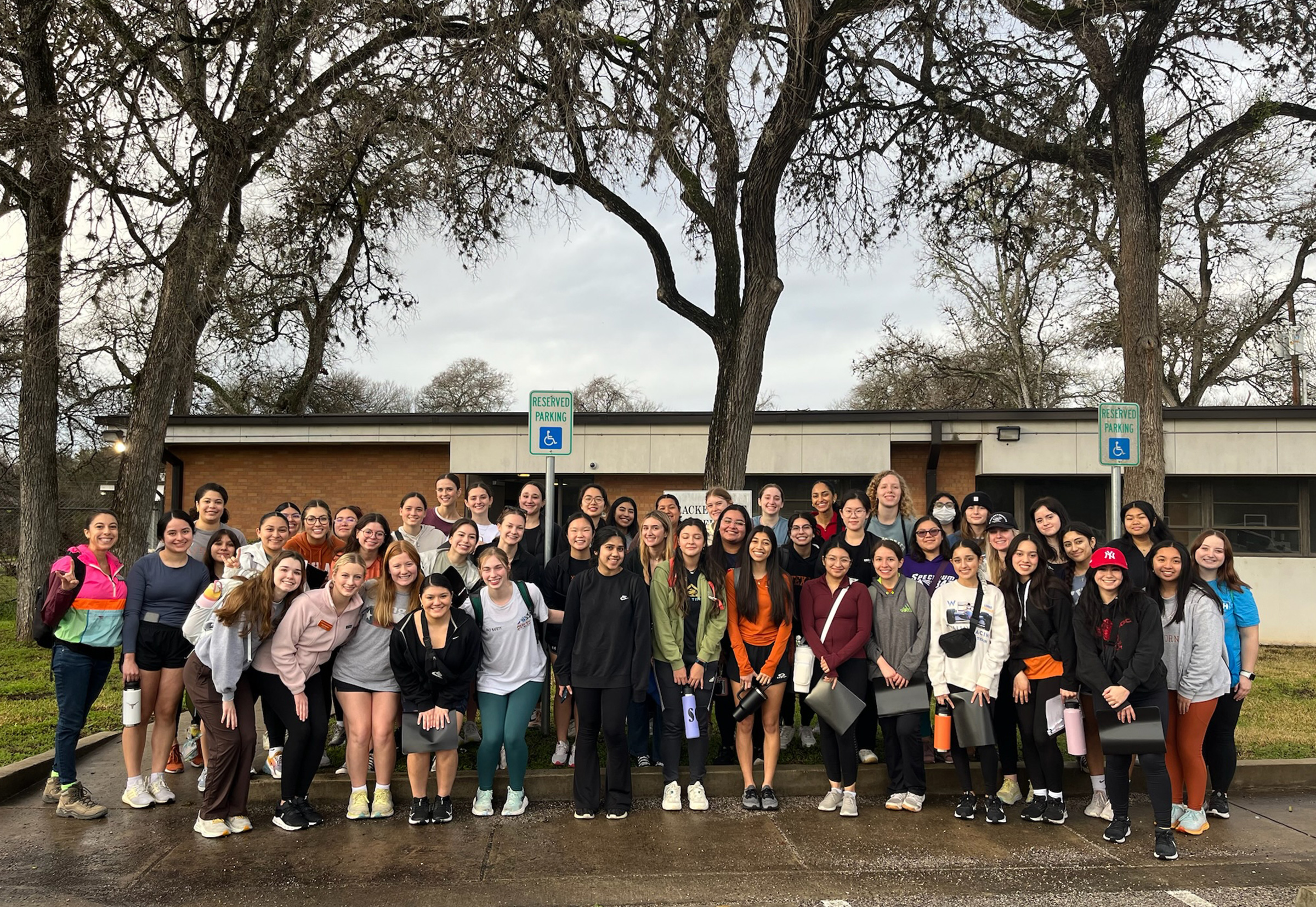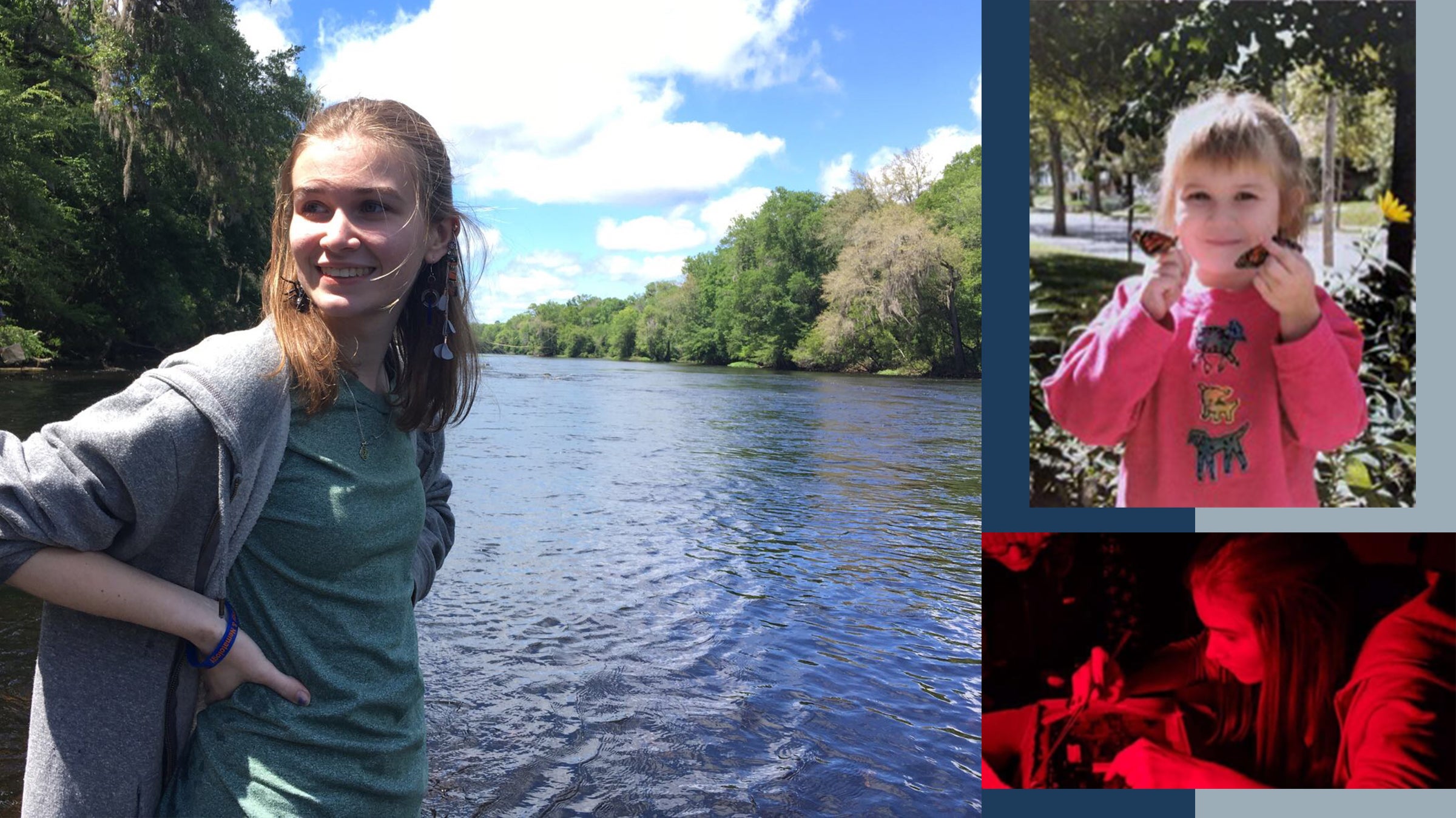
Saturday February 3rd was anything but a typical quiet day at Brackenridge Field Lab (BFL) as fifty future elementary school teachers from the College of Natural Sciences’ UTeach Primary program visited to learn about biodiversity and invasive species research in UT’s expanding Texas Field Station Network. The group enthusiastically toured the tropical butterfly garden, riverbank trail system, invasive species lab, and insect collection; learning ways to incorporate active research into their elementary school science curriculum. At the end of the month, UTeach Primary students led interactive Science, Technology, Engineering and Math (STEM) activities for 1000 local K-8 students and their families at UT Austin’s STEM Girl Day event to serve the local community.
Laura Chase, Assistant Professor of Practice in the College of Natural Sciences’ UTeach program, spearheaded the BFL field trip and UTeach Primary’s involvement at UT Girl Day. She sat down after these bustling outreach events to answer some of our questions.
How did you connect to Brackenridge Field Lab as a place to hold the event?
I teach UTS 306L, a Biology course for elementary education majors who aspire to be K-8 teachers after they graduate. I wanted my students to visit an active research site so they could interact with a variety of community members including professional scientists, postdocs, and volunteers to learn about biodiversity and invasive species research in the local Austin area.
I think it is important for educators to stay informed about current scientific research so they can connect K-8 curriculum to real-world applications and cultivate environmental awareness in their own elementary classrooms. The field stations in the Texas Field Station Network offer awesome hands-on learning environments where future teachers can directly engage with nature. This experiential learning deepens educators' understanding of biological concepts and ecosystems, which they can then convey to their students in a more meaningful way! I hoped that on this trip, my students would learn creative ways to incorporate outdoor learning into their teaching practices to foster a deeper connection between K-8 education, professional research, and the natural world.
I originally met with both Ken Wray [Managing Director, Texas Field Station Network] and Steve Gibson [Field Station Manager, Stengl Lost Pines] to select a field site for our visit. I was most interested in Brackenridge Field Lab and Stengl Lost Pines because the research being conducted there is most closely aligned to the Biological concepts my students study in UTS 306L. We ultimately selected Brackenridge Field Lab because it was the most accessible in terms of travel time and cost. However, we would love to build an ongoing partnership between UTeach Primary and the Texas Field Station Network and visit other field sites in the future!

Dr. Larry Gilbert inside the greenhouse at BFL.
What features about BFL did you feel were a good fit for the mission of Girl Day?
I was excited for our UTeach Primary students to design K-8 labs based on their field experiences at BFL, and gain hands-on teaching experience leading activities at Girl Day! Girl Day's mission is to broaden participation in STEM majors and career paths by: 1) providing opportunities for girls to participate in age appropriate, hands-on STEM activities and 2) giving girls diverse scientific role models in their communities. I am honored that we were able to participate in this empowering and impactful event!
Partnering with the Texas Field Station Network greatly enhanced UTeach Primary's booths at Girl Day because we were able to borrow engaging specimens for elementary students to interact with! For example, BFL staff organized petri dishes of native and invasive seed specimens for students to observe at Girl Day. This gave students background knowledge on wind-dispersal vs animal dispersal, and prepared them to participate in an engineering design challenge in which they designed their own invasive seeds to outcompete the dispersal range of native species. We also borrowed boxes of insect specimens from the entomology collection to teach elementary students about insect anatomy and mimicry. After observing cases of real insects, elementary students played interactive games to "spot the mimic" and categorize bugs as "insects or not insects." Students were absolutely FASCINATED by the insect collections!!
Furthermore, Ken Wray attended Girl Day alongside our UTeach Primary faculty to help prepare undergraduate students to lead their activity booths. Dr. Wray provided detailed information about the specimens collected at BFL, and gave students feedback on their teaching methods to improve the learning experience for our K-8 visitors!

Looking at fire ants in the Invasive Species Lab.
How do you think the event went?
I think the field trip to Brackenridge Field Lab and volunteering at UT Girl Day were both super meaningful learning experiences for our UTeach Primary students! 50 students attended the field trip, toured onsite facilities, and developed a stronger understanding of modern biological research. Afterwards, thirty of those students designed K-8 lab activities inspired by their field experiences and hosted booths at UT Girl Day to benefit elementary students in Austin. 986 elementary students eagerly visited UTeach Primary's booths at Girl Day, allowing us to make a sizable impact!
What kind of impact did you sense after it was over?
Here are some testimonies from UTeach Primary students about the impact that the BFL field trip and UT Girl Day had on their perspectives as future educators!
"After visiting BFL, I have a better idea of how to incorporate hands-on science into my own elementary school classroom. Even if my school site has a simple plot of grass outside, my class can take measurements of plants, observe animal behavior, and use AI to learn about the species that reside around our school community."
"I really enjoyed our time in the butterfly pavilion, learning the rules for introducing species into a new environment and seeing an abundance of plant and butterfly species that are native to the tropics."
"I liked learning about the fire ants! I was kind of grossed out by them, but it was interesting to see how they cling together to make a life raft to survive floods. We learned about mutualism in 306L, but most of the examples we saw were in videos or text. It was kind of crazy to physically observe this!"
"Visiting BFL helped me see the science in places I'd otherwise overlook."
"During Girl Day, I loved seeing how engaged parents were in scaffolding their child's learning experience as they moved about our presentation room. It made me think about ways to incorporate families more in the lessons I'll design for my future classroom."
"[At Girl Day] I learned how to ‘read the room’ and interact with students from different grade levels and different amounts of background knowledge. I also gained practical knowledge about how to prepare lessons for large groups of students.”
"All of the kids at Girl Day were so curious and excited to learn! I loved interacting with them and thinking about ways to make science fun and interactive in my classroom!"
The collaboration between UTeach Primary and the Texas Field Station Network provided invaluable hands-on experiences for future educators, bridging STEM disciplines and elementary education. Through engaging field trips and community outreach opportunities, students gained a deeper understanding of biodiversity and invasive species, while showcasing their commitment to inspiring the next generation of young scientists. These initiatives serve as catalysts for empowering educators and students to make a tangible difference in their communities through science education.

Postdoctoral Research Associate Colin Morrison presents his research on herbivory and biodiversity to UTeach Primary students.



